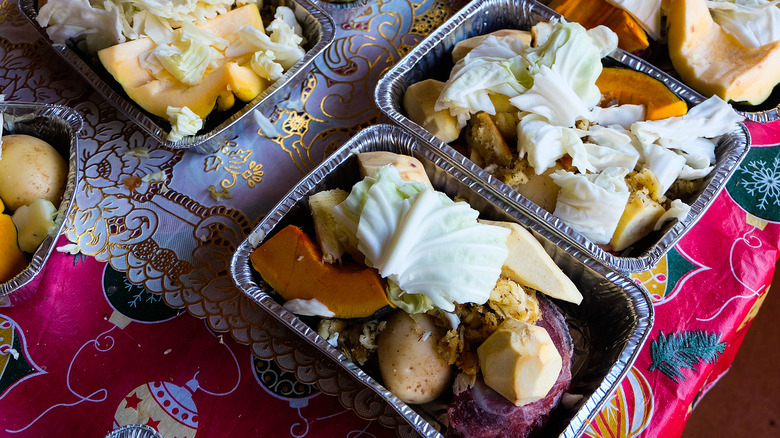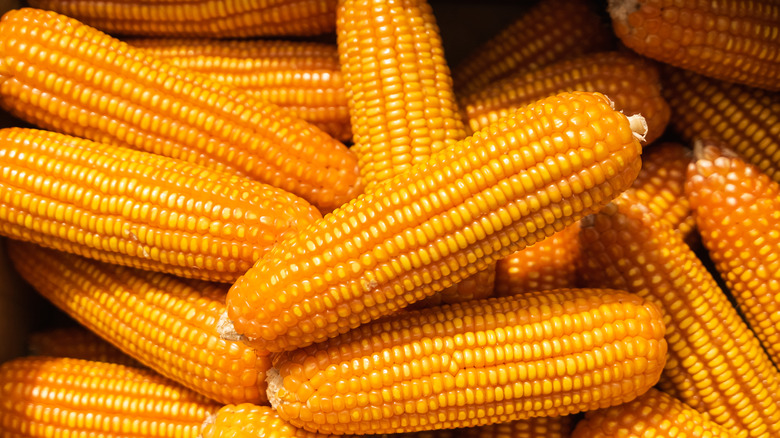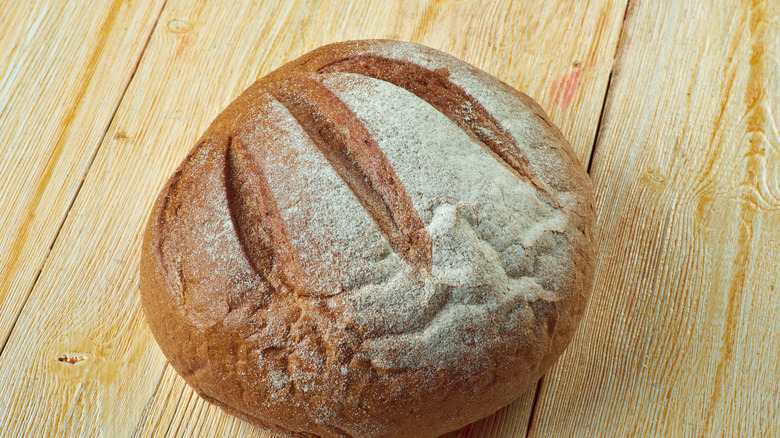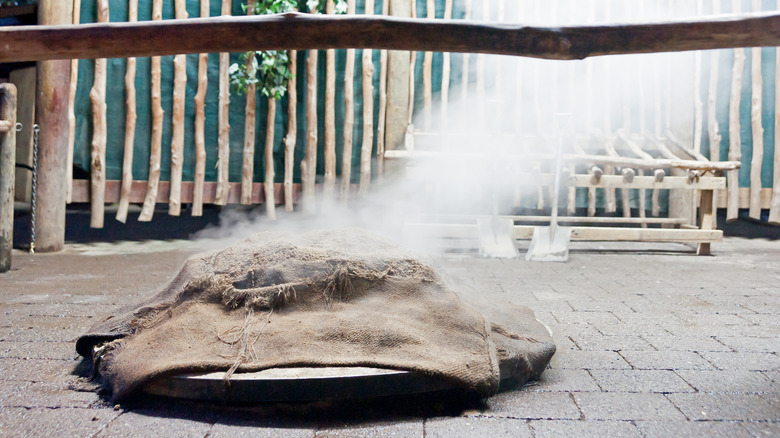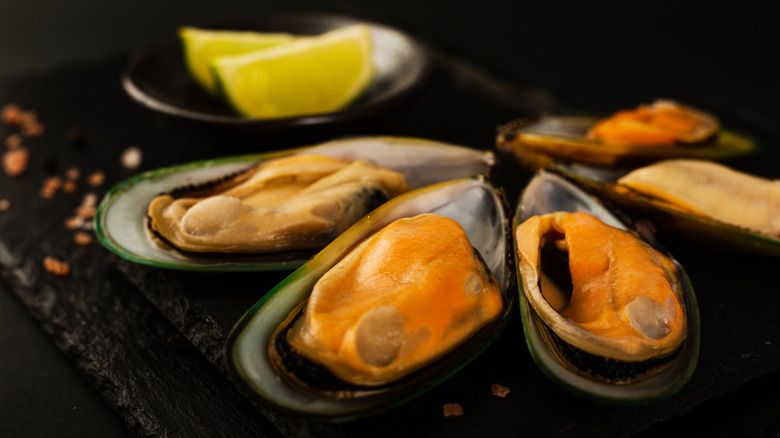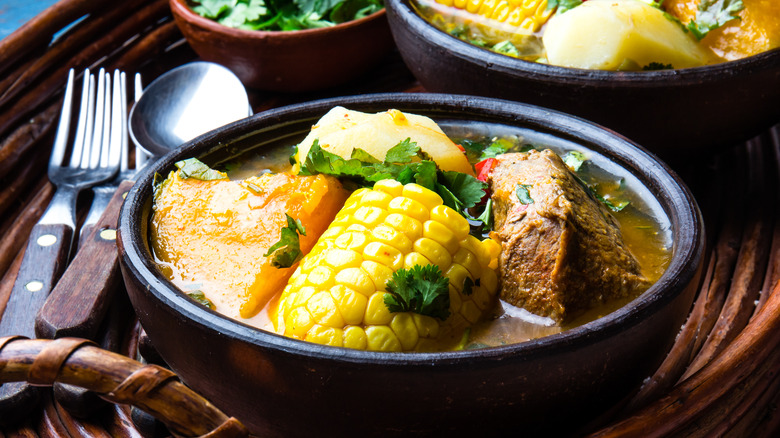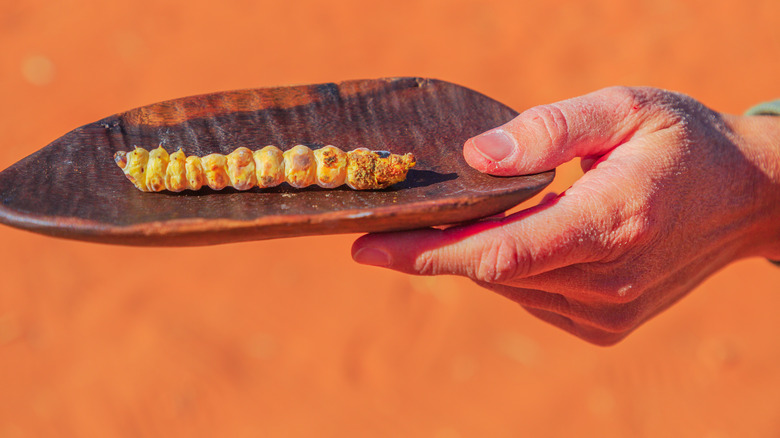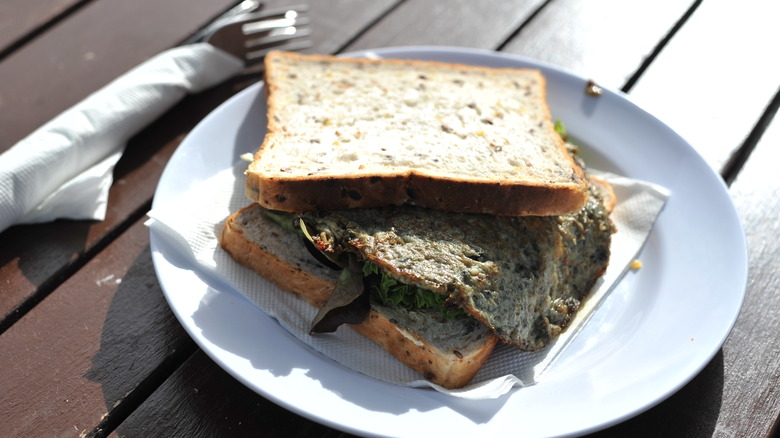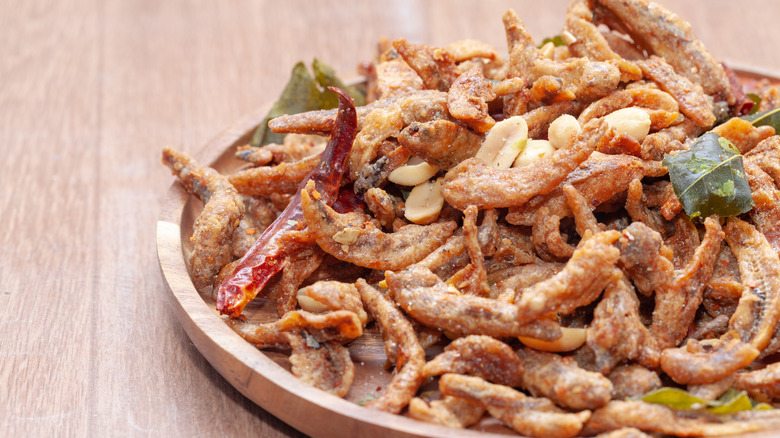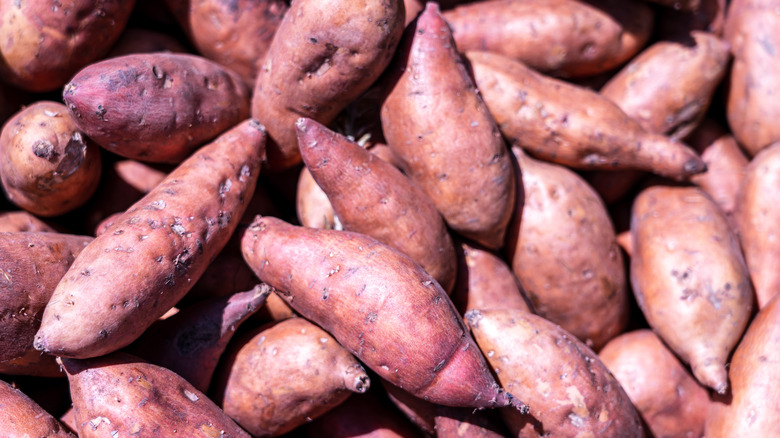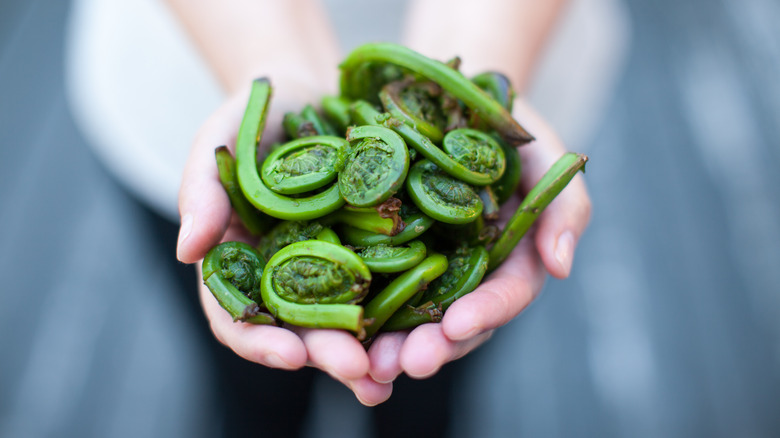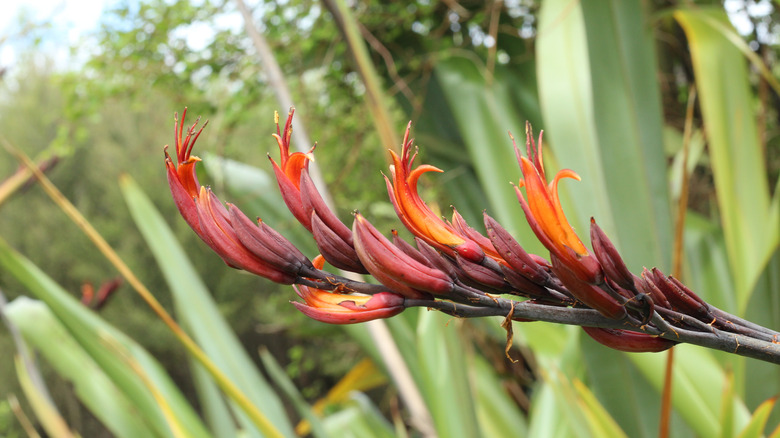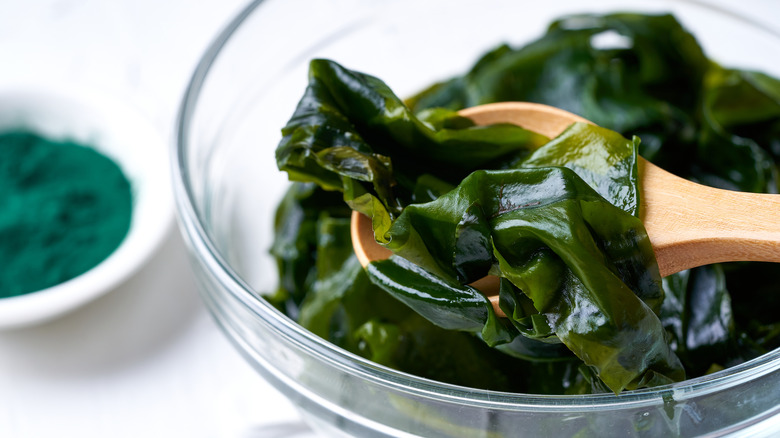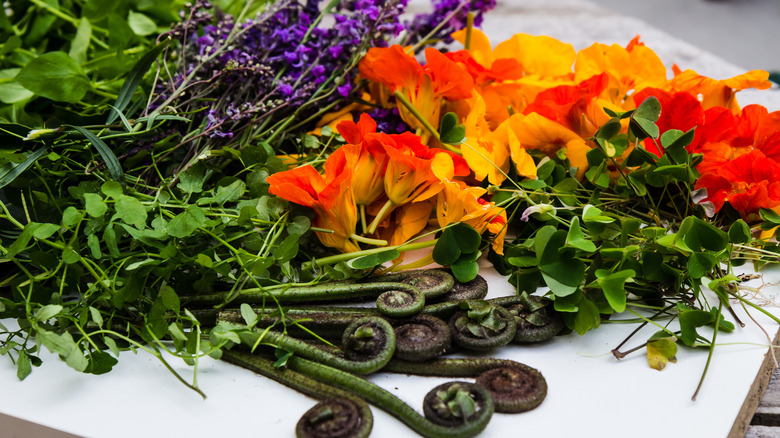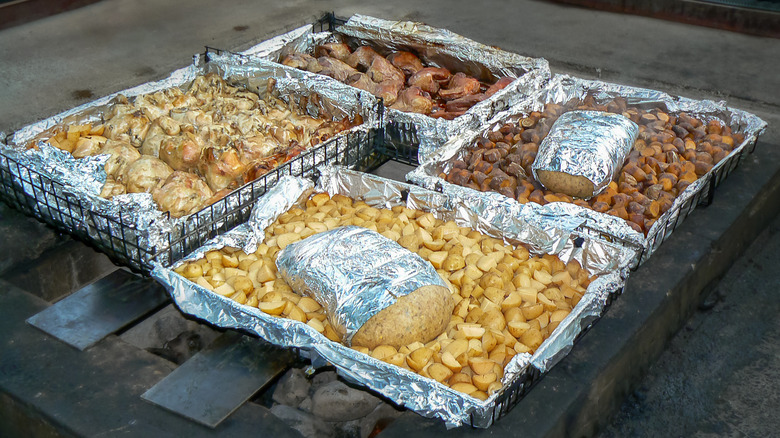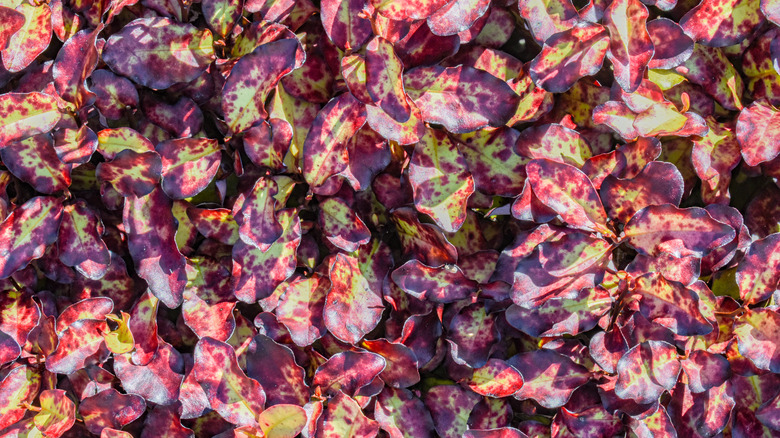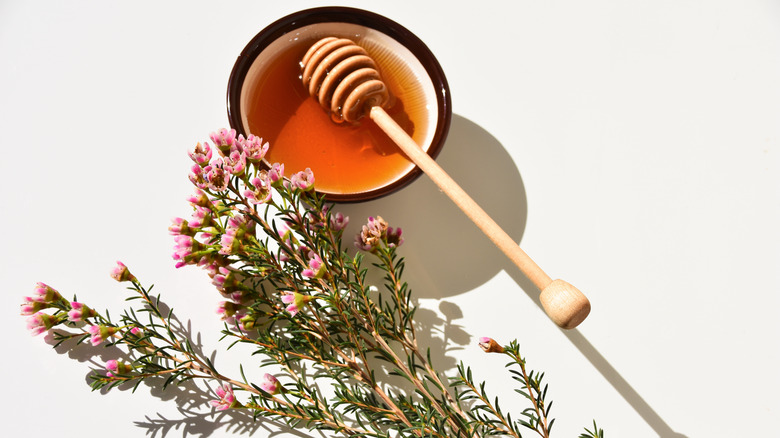16 Traditional Foods Of New Zealand's Māori People
The Māori have shaped New Zealand's cuisine and culture. The country's first inhabitants arrived by wooden canoe sometime in the 12th century from Eastern Polynesia, bringing many Polynesian traditions to the new land, known by the name Aotearoa within Māori culture. So foundational have the Māori been to the country and land that there is a growing movement to change the official name from New Zealand to Aotearoa to acknowledge te reo Māori, the culture's official language, (via The Guardian).
Today, those who identify as Māori make up around 17% of New Zealand's population, notes BBC Travel. Māori kai, or food, primarily consists of plants, fish, and birds indigenous to the island, alongside some traditions and seeds brought with them from Eastern Polynesia. It is largely underrepresented within popular food culture — however, there is a growing movement to bring the contributions, earth ethics, and sustainable practices that make up Māori cuisine into the public's awareness. Restaurants like Hiakai, dedicated to prioritizing and exploring Māori food sources and cooking techniques, are leading the way, winning awards from the Cuisine Good Food Awards and Chef of the Year, among others, (per Hiakai).
For those with their sights set on a visit to New Zealand, or for those who are just curious about the island's indigenous cuisine, here are just some dishes and flavors of the Māori we think you should know.
Kānga kōpiro (fermented corn porridge)
This dish was created by Māori communities after the settlement of Europeans in New Zealand and the introduction of new varieties of livestock and crops that accompanied them, including corn. By fermenting the corn's kernels, the food was able to last long past its summer growing season, stretching through winter. The fermentation process can take up to three months, after which the kernels are scrapped off of the cobs and mashed, (via Atlas Obscura).
The porridge has a deeply savory flavor and sour smell with strong notes of blue cheese created during the corn's fermentation process. You can eat the dish on its own or with the ash of the indigenous mānuka tree to create a slightly sweeter flavor.
Those not accustomed to eating this dish may find the smell challenging. However, like many traditional foods unique to a particular place, it is always worth trying whenever the opportunity presents itself.
Parāoa rēwena (sourdough potato bread)
This traditional dish has been made and eaten within Māori communities for many years. Like sourdough, this bread obtains its leavening agent from natural yeast fermentation. However, the sourdough starter for parāoa rēwena is cultured from potatoes rather than flour.
Like naturally fermented bread doughs, the process of proving is not for those in need of a quick result. Depending on the recipe used, bread can be baked for up to 16 hours! Like many food traditions, recipes for parāoa rēwena can vary from family to family, often passed down passed down through generations.
According to baker George Jackson, the bread symbolizes togetherness, sharing, and giving. Jackson works in partnership with Unesco to help keep the practice of making this traditional bread alive and well within Māori communities. Parāoa rēwena has been included in Unesco's list of global Breads of the Creative Cities project in an attempt to preserve its origins and traditions, (via RNZ). Like many good pieces of bread, it is usually enjoyed with butter and jam.
Hāngī
Hāngī is unique in Māori culture because it refers to both a cooking method and a dish. Reserved for special occasions and celebrations, the process involves cooking via heated rocks covered with a damp cloth, all contained in an umu or underground oven, often resting on or in hand-woven baskets rather than plates or in bowls. The cooking process takes several hours, producing tender food through steaming and baking — it's a labor of love. This underground cooking method is a traditional process for cultures within the Pacific Islands and beyond.
Though the cooking method remains the same, the ingredients are subject to change based on availability, season, and the number of people being fed. Initially, the technique was for cooking fish and root vegetables like kūmara (sweet potato); however, it has evolved to incorporate new ingredients. Today's dish often includes pūhā (pork), lamb, pumpkin, and cabbage.
Toroi (fresh mussels with pūhā juice)
Māori cuisine, known as kai, distinguishes itself with its fundamental pillars, including kai whanau, food from the land, and kai moana, meaning food from the sea. It is this acknowledgment of the environment as a resource that must be protected is built into the very language of the Māori people.
Toroi utilizes kai whanau and kai moana to create a dish of fresh mussels and a broth infused with the juice of a dark green sow thistle with a milk white sap and a bitter taste known as pūhā. Pūhā is most often paired with pork. The mussels used in this dish are a particular variety of green-lipped ones called kūtai, a common and popular type in New Zealand. Kūtai is also an essential part of the ecosystem, serving as a natural filtration system for the seawater and a source of food for both people and animals, (per Learnz).
Māori-led companies like Kono incorporate ethical sourcing to keep the reciprocal relationship the Māori have with the earth alive and a part of the business practice.
Māori boil-up
A traditional Māori boil-up is just as it sounds: a brothy stew. A conventional, modern day boil up will likely first include pork bones, vegetables like potatoes, sweet potato or kumara, carrots, and pumpkin. Leftover meats as well as vegetables are added about halfway through the cooking process to prevent them from breaking down completely. This dish is also known as pork and pūhā, named after the first ingredient to be included as well as the last.
Dumplings known as doughboys are added to create a tasty and hearty meal, with a heavy-handed garnish of watercress, pūhā, or other green vegetables added just before serving.
According to The Spin Off, boil-ups became even closer associated with the Māori sense of identity after World War II, when many began to leave their communities in favor of opportunities from more urban communities. Gathering over a boil-up became a symbol of community, associated with resilience and anchored identity for those who had left their home. Not only is it filling, but it also makes use of any leftover ingredients — it's a delicious way to reduce kitchen waste.
Huhu grubs
Eating bugs and insects is a practice that has been around since man could walk, probably even before then. The practice, known as entomophagy, is used globally and regularly in a variety of different ways. From crickets in Mexico to winged termites in Ghana, (via National Geographic), insects are considered an incredibly sustainable source of protein, making them a perfect choice for both people and the planet. Such is the case there are an increasing number of companies and start-ups working to incorporate insects into their food products, whether ground into flour or mixed into protein bars, adds Investor Junkie.
So too, this is a part of Māori kai. Known as huhu grubs, these little critters are most frequently eaten raw and known for a rich "buttery-chicken" flavor. Huhu grubs are often found in and under rotting logs from which they feed. They are best eaten before they enter their 25-day pupa stage, during which they transform into flying beetles.
Paua fritters
Fish and seafood play a considerable role in Māori cuisine or kai, known as kai moana, meaning food from the sea. Mussels, clams, sea urchins, oysters, crayfish, and abalone (or paua) contribute to the diverse and incredibly healthy diet obtained from fresh and saltwater bodies, including the ocean and streams. Kai moana, according to Matador Network, has significantly influenced the overall cuisine and popular dishes across New Zealand.
Paua, or abalone, is a meaty sea snail, best found along the coast of the South Island. It is considered a delicacy within Māori culture, and its commercial harvesting is regulated by law in order to preserve the species, (via The Conchological Society). Its iridescent shell alone is a thing of beauty.
Paua are prepared in a variety of ways, including creamed, eaten raw, steamed as part of a hāngī, and diced alongside onion and fried into a much-loved fritter. The fritter method, though popular, reflects the influence of European settlers, the ingredients brought with them to New Zealand, and the adaptation of Māori people to include new methods of cooking indigenous ingredients.
Īnaga (Whitebait)
Whitebait, or inaga, is a small, almost translucent, freshwater fish used in various ways within Māori and Kiwi cuisine. By small, we mean around 2 inches long. Such is the case, they are often eaten in multitudes. For those outside of New Zealand, Australia, and parts of Europe, where the species live or are exported to, whitebait is likely not as familiar of a fish as other types like salmon, tuna, or tilapia.
Across New Zealand, the dish will usually appear on menus either deep fried, to eat as a snack alongside a cold drink or beer, or in a fritter, as are many other kinds of seafood. According to Matador Network, the traditional Maori way of cooking them involved steaming in a Hāngī. Much like sardines, anchovies, or any other small oily fish, their flavor is incredibly fishy, with tiny edible bones containing high amounts of calcium (via NHS.uk).
Root vegetables
Root vegetables have been a longstanding staple in Māori traditions before and after European contact. Māori people initially made their journey to now-New Zealand from the Pacific Islands, bringing with them many things including yams, taro, and the kūmara, an intensely sweet potato available in an array of colors, red, gold, and orange, (via Eat New Zealand). Kūmara are a traditional ingredient, included in most hāngī, a traditional underground cooking method that uses hot rocks and a wet cloth to produce tender and delicious results.
Kūmara now grows in the more tropical regions of the country, like the north island also known as Te Ika-a-Māui. It is here where the majority of Māori communities and culture live and thrive. For those interested in immersing themselves in the culture to garner a deeper understanding and appreciation of the Māori kai (food), dance, art, and way of living, a trip to the north island comes highly recommended, (via New Zealand Sky).
Pikopiko (fern heads)
Pikopiko, or fiddleheads, (the North American name for them), are just one of the wild foods used regularly in the indigenous cuisine of New Zealand. Picked when young and plump, pikopiko are the new shoots of the mamaku plant, which, according to chefs like Joe McLeod, can make for a wonderful alternative to potatoes due to their starchy nature, (via BBC Travel).
Mamaku ferns are often found in damp, shady areas, their shoots still tightly curled into shy little spirals of green. Notably, when their pikopiko or shoots are picked after they have unfurled, it's too late; not only is their flavor similar to other fresh green vegetables like beans or asparagus affected, but they become entirely inedible, adds Atlas Obscura.
Pikopiko also serves as a muse, represented in a variety of ways. The spiral is considered to be a symbol of unity within Māori culture. Often two pikopiko are featured in artwork and jewelry as two intertwined spirals, creating a new character called the pikorua, (per Mountain Jade).
Harakeke
Harakeke is a beneficial all-purpose plant indigenous to New Zealand. It thrives in wet environments and is recognizable by its flower-filled stalks in strikingly vibrant shades of sunset colors including red, orange, yellow, and pink. Harakeke is part of the flax family, known for its heartiness, versatility, and health benefits.
The plant's leaves are used to make traditional woven baskets which are often used in cooking, like in hāngī and otherwise. Its fibers can also be treated and softened to use in the making of clothing, (via Aotea). It can also be processed medicinally as a means of helping with various issues. Its seeds and oil contain omega-3, (via Te Pa Tu). Once you know of its existence, it is a plant that you can't help but see examples of its use everywhere you turn in New Zealand. It's no wonder it is such a staple in Māori culture.
Korengo (seaweed) and kelp
Given the proximity to the sea from nearly any place in New Zealand, approximately no more than 140 kilometers, adds Te Pa Tu, it comes as no surprise that not only fish and seafood, but seaweed and kelp, known as korengo, are also a large part of the indigenous diet.
On a global level, seaweed is becoming increasingly known for its nutritional benefits as well as its taste. Michelin-starred chef Jun Tanaka has flagged it as a food trend for 2023, (via Metro). According to Healthline, seaweed is high in antioxidants and iodine, supporting and boosting heart and thyroid health. These benefits are something the Māori, Japanese, Korean, and Chinese cultures have long since understood; the ingredient is used widely within these cuisines. The umami-rich sea vegetable has been incorporated into the daily diets of many, in a variety of forms from fresh to dried, for thousands of years.
Bitter greens like kowhitiwhiti (watercress) and pūhā
Bitter flavors are often prevalent in nature, yet our palates tend to only appreciate them with age and persistence, training our palates to appreciate and enjoy flavors that babies and children instinctively reject. Professor Russell Keast of Deakin University credits this with understanding the positive effects a bitter food or drink has on our bodies; feeling awake thanks to the bitter coffee we've consumed or relaxed thanks to the beer.
This bitterness can be found in various cuisines, from green teas to citrus fruits, grapefruits, and a variety of vegetables, including radishes, endive, and radicchio. Bitter foods also tend to be nutritional powerhouses and can aid digestion, (via Desiree Nielson).
This flavor appears in many wild vegetables and plants used within Māori kai. Pūhā, a dark green thistle, and kowhitiwhiti, a wild and mustard-flavored watercress-like plant, are often used to finish off stews like boil ups, or in seafood broths like toroi and are frequently paired with pork. Kowhitiwhiti can also be eaten raw, like your favorite bitter greens salad.
Tītī or muttonbird
Most of the time when eating new-to-us meats, they are described as "tasting like chicken." The titi or muttonbird is the opposite. This duck-like bird, residing predominantly on Rakiura or Steward Island in the southern region of New Zealand, is reported to taste not of chicken (or duck) but of mutton, thus explaining its name. Known for its meaty, gamey taste, the tītī is a traditional and now protected part of the Māori diet.
Because of their significance within the culture, Māori communities have exclusive collection rights of the bird's chicks during the specified hunting season, beginning in April and ending on the last day in May. Due to this short season, it can be a significant event for many families and communities. After being caught and processed, the birds are often preserved in salt until ready for use in a hāngī or otherwise, (via Teara).
Traditional ingredients like this bird are prevalent on menus like Hiakai in Wellington, a restaurant dedicated to celebrating Māori traditions and foods, the oldest in New Zealand. Chefs like Monique Fiso are helping to bring these foundational ingredients and practices back into public awareness.
Horopito (peppertree)
Horopito is an indigenous New Zealand tree prevalent in its mountainous forests. Horopito leaves are often a mixture of greens punctuated with drops of reds and oranges with a pronounced deep red or purplish border. Due to their anti-fungal properties and spicy flavor, they have repelled many predators and continue to thrive in the bush, (via Organic NZ).
Like many other plants within Māori kai, the horopito plant serves multiple functions. Leaves are also used medicinally, often steeped to create tinctures or chewed. Known uses include the treatment of toothaches, stomachaches, or topical skin issues depending on how they are processed or eaten, (per Kiwi Herb).
Their fresh citrus-meets-peppery flavor also makes a great seasoning used in various dishes. Leaves can be used fresh or dried and ground as an alternative to pepper. Horopito can be used in marinades to flavor meat and fish, sprinkled onto vegetables, or even used as an infusion for olive oil or tea, or combined with sea salt, dried citrus peels, and other herbs to create a delicious rub.
Mānuka
One part antiseptic (commonly known as tea tree), one part natural sweetener, the mānuka plant, native to New Zealand, is a vibrant and much-loved resource to all who know it. In recent years, mānuka honey has made its way into many areas of food media, touted as not only delicious but one of the healthiest kinds of honey around, a natural anti-inflammatory and rich with antioxidants, (via Healthline).
Not only is mānuka valued for its honey, but its wood is also used for smoking meats and fish, infusing its naturally sweet and earthy flavors into foods cooked over it, (per Nature & Nosh). Its honey, produced by flowers in bloom for only two to six weeks annually, has also been used by the Māori to bring down fevers, treat stomach ailments and burns, and sweeten and flavor food. According to New Zealand Story, it is known as a taonga, or treasure, by the Māori due to its ability to make everything it touches a little better.
